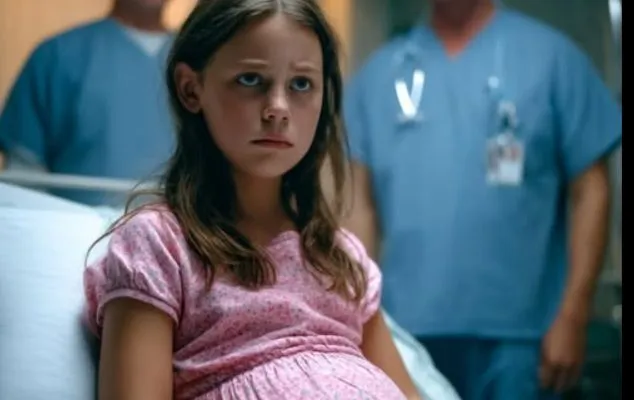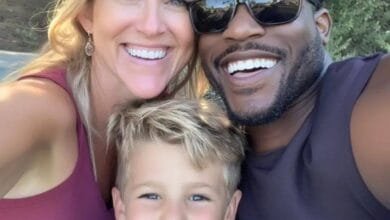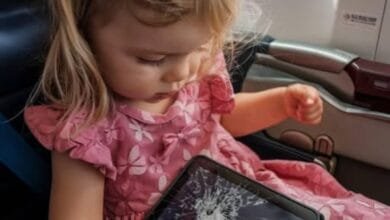“Strength Is in the Soul” – The Story of Kira

A 12-year-old girl with a severely swollen belly was rushed to the hospital. At first, the doctors suspected digestive issues or possibly a tumor. But when they performed the ultrasound, silence fell over the room. What they saw left them frozen. It wasn’t a pregnancy or a tumor—just a faint sign of life, barely holding on.
Her name was Kira. Thin, pale, and quiet, with big blue eyes. Her hands clutched her belly constantly, as pain never left her. Her mother, distressed, cried:
— I thought it was just bloating… gas… But she screamed in pain at night, curled up… and now, she can’t even stand.
Since the age of six, Kira lived only with her mother after being abandoned by her father. Her mother worked as a janitor in a shopping mall, doing all she could to support them. They lived in poverty, but love filled their home. Despite the pain, Kira smiled so her mother wouldn’t worry. She drank water slowly, hid her hunger, and endured.
At the hospital, doctors rushed to help. Kira couldn’t even stretch her legs — her belly’s skin looked ready to burst. After many tests and conflicting diagnoses, they finally found the answer: intestinal lymphangiectasia — a rare disease that causes lymph fluid to accumulate in the abdominal cavity. Its pain can be mistaken for a simple stomachache.
An experienced doctor with gray hair told the mother:
— Your daughter is incredibly strong. Her body has been fighting for months. But now, she needs you more than ever.
Her mother never left the room. And when Kira finally woke up, she whispered:
— Mom… I don’t want to die. I haven’t finished my favorite show yet…
Three liters of fluid were drained. Every procedure was painful, but she held on. She received a teddy bear with a bandage on its belly and asked:
— Is he going to be sick with me?
After two weeks, she started improving. The medical team was amazed by her strength. A quiet nurse brought her a warm blanket and whispered:
— You’re like an angel. Just don’t go away, okay?
Kira became an inspiration. Her story spread through the clinic.
But one Sunday night, her fever spiked, and her legs swelled. Doctors rushed again, afraid her body was giving up. But once again, she pulled through. When she woke, she smiled and asked:
— Mom… can I have some chocolate later?
At 14, Kira was undergoing rehab and wore a necklace with her mother’s photo. She dreamed of becoming a doctor. The words of a kind-eyed doctor never left her mind:
— You are stronger than most adults. You deserve to live.
Today, her photo hangs in the gastroenterology wing, with the caption:
“Strength is not in the body. Strength is in the soul.”
Recovery came at a cost. Her mother lost her job but never complained:
— The most important thing is to survive. Everything else will follow.
They moved into a small room at a factory dorm, offered by an aunt. It was modest—faded wallpaper, an old TV, a rusted stove. But Kira smiled — because she was alive. The illness, however, hadn’t disappeared. The cramps came back. Her belly swelled again. But now, she knew how to face it.
At school, she was the target of gossip:
— She looks pregnant… Gross, she probably has worms!
She pretended not to hear. Only one boy, Lesha, sat beside her and said:
— My mom says you’re the strongest. I’d cry every day.
And at that moment, Kira realized: she didn’t just want to survive. She wanted to live.
— I’m going to become a doctor. Like those who never abandoned me.
Four years later, Kira entered medical school. The whole neighborhood helped with donations. Her mother found a new job at a clinic. But in her second year, a fire broke out in the dormitory. Everyone got out—except Nastya, a freshman.
Kira ran in to save her, even in her fragile health. She rescued her but ended up hospitalized for two weeks with lung burns. From then on, Nastya became her best friend. Her pillar.
The disease returned. Kira woke with her belly stiff as a drum, just like when she was a child. She knew what to do. She and Nastya traveled to a specialist. The doctor confirmed:
— You need urgent surgery. But you came just in time.
It was a tough surgery—transfusions, removal of damaged vessels, weeks of recovery. Her mother arrived and knelt by her bed:
— I’m sorry… I thought you were just tired…
Kira smiled:
— I’m growing. I’m enduring.
She took a break from college. Nastya took care of everything. Kira started a blog for teenagers with rare diseases. No drama, just truth.
The blog reached thousands. A 9-year-old girl named Alina, with the same condition, reached out. Her mother begged for help. Kira welcomed them, took Alina to the doctor, read her stories, and stroked her hair.
Six years passed.
Kira graduated, became a paramedic, and started working. But fate struck again — Lesha, the boy who once called her strong, died in an accident. Her first love, never confessed. She burned his letters and moved on, heartbroken.
Ten years after her diagnosis, Kira was back in surgery — but now as a doctor. She treated an 11-year-old girl with the same condition.
The mother, in tears, asked:
— Will she survive?
Kira gently held her hand:
— I was once just like her. And I’m here. Your daughter will live.
Kira never became famous. Never went abroad. Never married. But her apartment always smelled of mint, books, and hope. She wrote a book called “Inside the Pain,” now studied in medical schools.
One day, a woman showed up with a little girl:
— Are you Kira? I’m Alina. The one you saved. And this is my daughter. I named her after you.
Kira cried — but for the first time in years, with joy.
💳 Credit Card: A Powerful Ally or a Dangerous Trap
In today’s world, credit cards have become an essential part of daily life. They offer convenience, purchase security, installment plans, and even perks like miles and cashback. But what many fail to realize is that if not used wisely, a credit card can quickly become one of the biggest financial traps of modern life.
The real problem isn’t the card itself, but the unconscious, uncontrolled use of it. Contrary to popular belief, the credit limit is not extra money—it’s a line of credit, meaning borrowed money you must repay, often with very high interest if delayed or split into payments.
It’s common to see people spending beyond their means, clinging to the illusion of “the bill only comes next month.” But when those purchases pile up, reality hits hard. Without planning, the amount snowballs into something unmanageable.
This leads to what is known as revolving credit—one of the highest-interest debts in the market, often exceeding 300% per year. The result? The dreaded “snowball effect”: the more you pay only the minimum, the larger your debt grows.
But it’s not just about money. Financial pressure brings emotional consequences—anxiety, stress, and loss of quality of life. Many people give up on dreams and goals because of debts that started with small, avoidable purchases.
How to use credit cards responsibly:
✅ Plan your spending: Only use the card for expenses you can cover in full by the due date.
✅ Avoid paying the minimum: Pay the full balance whenever possible.
✅ Don’t own multiple cards: More cards = more risk of losing control.
✅ Set a personal spending limit: Even if the bank gives you a high limit, set your own based on your income.
✅ Track your purchases: Keep records or use apps to monitor your expenses in real time.
✅ Be wary of “interest-free installments”: Even without interest, the total adds up and may strain future budgets.
Awareness is Freedom
A credit card can be a powerful financial tool—if used wisely. But when used to maintain a lifestyle beyond your means or as a quick fix for financial problems, it becomes a trap.
Educate yourself financially. Plan. Think before you swipe. Use your card as an ally, not an enemy. True credit is the one that fits your budget and respects your peace of mind.





